|
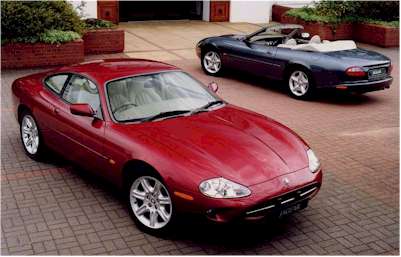 The original
XK8 was launched in 1996 as a convertible or coupe. Equipped with the
all new 290hp aluminum V8, 5 speed automatic transmission, and 17"
wheels, the successor to the XJS was very well received by enthusiasts
and the press alike. The all curve styling was very different from the
XJS but brought back memories of the E-Type. The original
XK8 was launched in 1996 as a convertible or coupe. Equipped with the
all new 290hp aluminum V8, 5 speed automatic transmission, and 17"
wheels, the successor to the XJS was very well received by enthusiasts
and the press alike. The all curve styling was very different from the
XJS but brought back memories of the E-Type.
As
all Jaguars, the XK8 pampers the driver and his passenger with Connoly
leather, rich wood veneers and all the comfort expected.
On
the performance side, the 290hp engine provides plenty of power giving
the XK8 performance similar to the Mercedes SL500. The ride
is more precise than the XJS predecessor but still offers the qualities
expected from a Jaguar.
When
it was introduced, the XK8 was the first car totally designed and conceived
following the Ford take over in the late 80s. Until then, Jaguar had
a serious image problem with poor reliability, something which had been
improving steadily since the Ford take over. The XJ6 sedan, largely
redesigned in 1995 was the first car to benefit from Ford large investments
and the XK8 turned out to be a well engineered and reliable car. This
recovery peaked in 1999 when Jaguar took coveted 1st place in the JD
Power owner satisfaction survey.
Click
here for Technical Specs and performance information
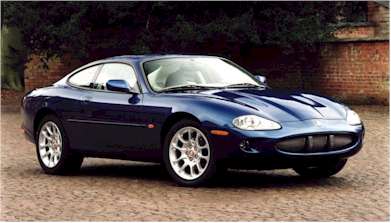 Launched
in the UK in early 1999 and in the US in November 1999, the XKR Coupe
or Convertible features the 370hp supercharged, twin intercooled version
of the V8 already used in the XJR sedan. Launched
in the UK in early 1999 and in the US in November 1999, the XKR Coupe
or Convertible features the 370hp supercharged, twin intercooled version
of the V8 already used in the XJR sedan.
Very little
was done to differentiate the cars. The only exterior differences are
: red background badges, 18" wheels compared to the XK8 17",
a mesh grille instead of the horizontal bar, twin functional louvers
on the bonnet and a small boot lid spoiler.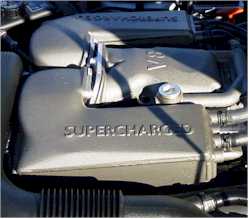
In addition
to the supercharged engine, the XKR is equipped with a special Mercedes
5 speed automatic transmission.
The additional
80hp and wider torque range, transform the car into a true high performance
car with superior handling characteristics. As the fastest road
going Jaguar ever produced, the XKR steps in the league of Porsche 911,
Corvettes, and other exotics.
All for a
price which while not exactly cheap and affordable, is reasonable considering
the performance. The XKR is often compared to its corporate cousin,
the Aston Martin DB7, in part because of their styling and performance
level but the XKR retails at a cost that's almost 40% less.
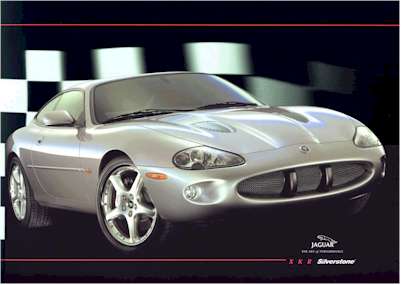 This special limited
edition of the XKR was created by Jaguar to celebrate its return to
competition with the Formula One team. Named after the famous British
track where Jaguar experienced so much success it shares the same drivetrain
as the normal XKR. This special limited
edition of the XKR was created by Jaguar to celebrate its return to
competition with the Formula One team. Named after the famous British
track where Jaguar experienced so much success it shares the same drivetrain
as the normal XKR.
In addition
to badging and special inside trim, the difference comes in the handling
department with 20" wheels, lowered and stiffer suspension with
beefed up antiroll bar, and larger crossdrilled Brembo brakes. Most
of these where developed for the XK180 concept car and are available
in Europe as dealer installed option under the R performance Option
designation. As of October 2000, they are expected in the US but not
available yet.
Production
wise, Jaguar originally announced a limited run of 50 convertible and
50 coupes for the home market in march 2000. Later on, another series
of 200 ( 175 convertible and 25 coupe ) was announced for the US market
and started arriving at dealership in October 2000. While MSRP for the
convertible is close to $ 100 000, most if not all dealers are actually
asking well over sticker due to the limited production.
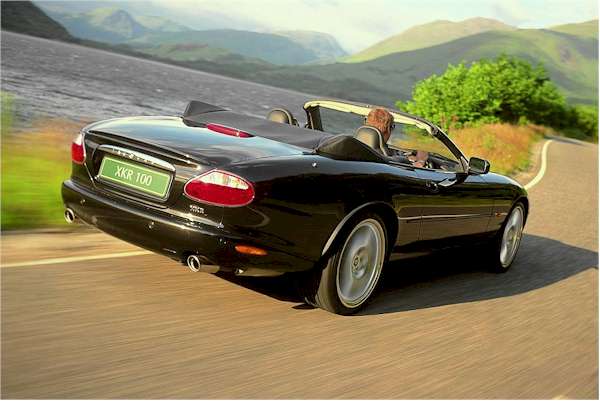 After
the limited edition 2001 XKR Silverstone, Jaguar unveiled the 2002 XJR
100 and XKR 100. Both high performance cars, available only in Anthracite
Black are named to celebrate the centenary of Jaguar founder Sir William
Lyon. After
the limited edition 2001 XKR Silverstone, Jaguar unveiled the 2002 XJR
100 and XKR 100. Both high performance cars, available only in Anthracite
Black are named to celebrate the centenary of Jaguar founder Sir William
Lyon.
Both cars,
powered by the same 370 hp supercharged V8 found in standard R models,
come equipped with R options including wheels, brakes and suspension;
the wheels are new BBS 9 spoke alloys. Jaguar’s Computer Active
Technology Suspension first introduced on the XKRs will be standard
on the XJR 100 saloon as well.
The interior
features Charcoal leather with a new R option steering wheel and shifter
know. The XKR 100 also features additional aluminum trim including sports
pedal, and special Recaro performance leather seats.
Both comes
with premium sound system, DVD navigation system, rain sensing wipers
and reverse park control in addition to the impressive list of standard
features
Only 500
XJR 100 and 500 XKR 100 ( coupes and convertibles combined) will be
available worldwide.
Click
here for the full press release
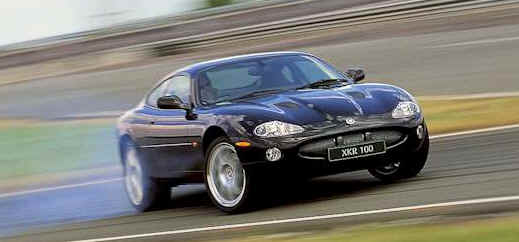
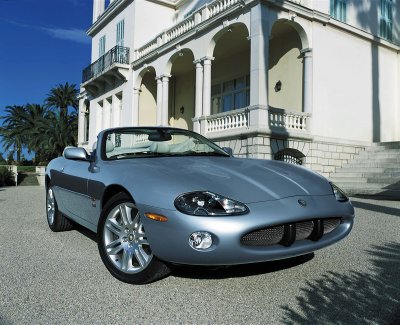 As
expected following the introduction of the new 4.2 litre V8 in the
revised S-Type, Jaguar announced some significant improvements on
the 2003 XK range starting with a new drivetrain. As
expected following the introduction of the new 4.2 litre V8 in the
revised S-Type, Jaguar announced some significant improvements on
the 2003 XK range starting with a new drivetrain.
The new 4.2 Litre V8
is not just larger than its 4.0 predecessor but it also has been heavily
modified (see list below). Power is now 300hp DIN in the base version
found in the XK8 and a massive 400hp DIN in supercharged trim which
comes to about 393hp SAE.
The 5 speed automatic
transmission is now replaced by a new 6 speed ZF providing closer
ratios with the same silky smooth shifting. Jaguar thankfully kept
its trademark J-Gate, slighly improved as well, which provides semi
manual control of 2nd thru 6th gear.
Top speed is still electronically
limited to 155 mph and acceleration remains unchanged with the XKR
coupe reaching 60 mph in 5.2 sec. and 6.1 for the XK8.
Electronics have also
been modified and enhanced including revised dynamic stability and
traction control, revised CATS ( Computer Active Technology Suspension
), emergency brake assist, adaptive cruise control and more.
Inside the car, the
dash and console is unchanged except for new 12 way power seats and
a new sporty leather shift knob. The unique and elegant wide veneer
dash is retained with deeply sunken primary instruments. The seats
are now available with contrasting leather.
Outside, with such an
elegant design there was very little to improve and the only differences
are Xenon headlights, badging and new wheels.
In addition to the R Performance
options ( handling and wheels) a new 'Aluminium Pack' is now offered
comprising instrument bezels, J-Gate surround, door release levers,
pedal pads, tread plates, and all-leather steering wheel rims and
gearshift knobs. Brembo Brakes previously optional are now standard
on the XKR.
| New engine features
: |
Other new features
: |
| -
Capacity increased from 3996cc to 4196cc, with bore and stroke
of 86.0/90.3mm (previously 86.0/86.0mm).
- Naturally aspirated XK8 engine
produces 300bhp (DIN)and 420Nm (310lb ft) of torque. Supercharged
XKR produces 400bhp (DIN)and 553Nm (408lb ft)of torque, with
more than 86 per cent of peak torque available from just 2000rev/min.
- Eight cylinders in 90 degree
vee, five main bearings, in naturally aspirated and mechanically
super charged versions.
- Aluminium-alloy block and
cylinder heads for light weight in a compact package with maximum
rigidity and strength.
- Redesigned block and bed-plate
make new engine even lighter and stiffer than original, further
improving refinement.
- Four chain-driven overhead
camshafts operating four valves per cylinder with variable inlet
and exhaust camshaft phasing.
- Revised camshaft drive further
reduces loads and already extremely low levels of radiated noise.
- Valve clearances require
no adjustment for life.
- XKR uses belt-driven Eaton
rotor-type supercharger with intercooling, now with helical
rotor gears for low noise and coated rotors for maximum efficiency
both industry firsts on a production engine.
- Supercharger speed increased,
and volumetric efficiency further improved.
- Improvements to fuel-injection
system further improves efficiency and reduces emissions.
- Electronic Engine Management
System features 'drive-by-wire' throttle action with 'get-you-home'
facility.
|
- New 6 speed automatic transmission
from ZF
- Race-bred Brembo brakes now
standard on XKR, optional on other models.
- Dynamic Stability Control
(DSC), Emergency Brake Assist (EBA) and Cruise Control standard
across the range. Adaptive Cruise Control (ACC)is an option,
and now features Forward Alert, an audible driver warning system
that senses and responds to slowing traffic ahead.
- Features Jaguar's world-leading
Adaptive Restraint Technology System (A.R.T.S.)with world 's
first Ultrasonic Occupancy Sensing
function.
- Automatic headlights-on and
rain-sensitive wiper functions; Xenon headlights with automatic
self-levelling standard on XKR, and a cost
option on XK8.
- Electrically adjustable steering
column with entry/exit mode now standard on all models (memory
optional). New equipment options include upgraded DVD-based
navigation system and electrochromatic mirror with compass.
- Range of new alloy wheel
designs available as options.
- Four new exterior colours:
Jaguar Racing Green, Ebony, Midnight and Adriatic Blue.
- New interior trim options
include 'contrast ' finishes that feature Warm Charcoal contrasted
with Heritage Tan or ranberry on sports style seats.
|
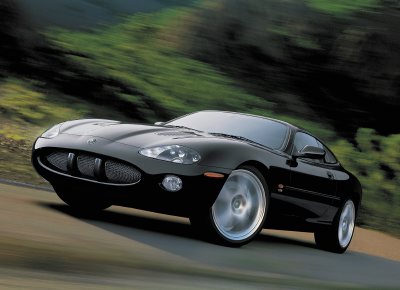
About the new V8...
Jaguar's new AJ34 family of engines
was developed at the Jaguar Engineering Centre at Whitley in Coventry.
Designed to deliver more performance, better economy and improved
refinement when compared with the original AJ28 AJ-V8 from which it
has evolved, the AJ34 retains the same compact, 90 degree V8 dimensions
but is structurally even stiffer.
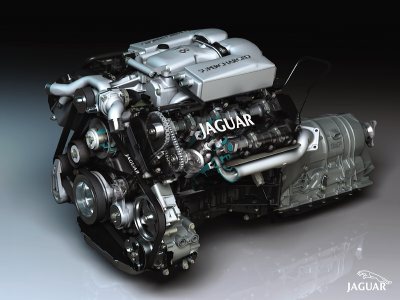 Capacity
is increased to 4196cc, with bore and stroke now 86.0 x 90.3mm. With
a ribbed block and cylinder heads, the engine is very light but extremely
strong, its best-in-class stiffness minimising radiated engine noise
and increasing mechanical reliability. The four-throw, six balance-weight
crankshaft is supported in five main bearings and the connecting rods
feature fracture-split big-end journals, for strength with light weight
and perfect balance. Mechanical refinement is improved, reducing engine-generated
noise and vibration even further. Capacity
is increased to 4196cc, with bore and stroke now 86.0 x 90.3mm. With
a ribbed block and cylinder heads, the engine is very light but extremely
strong, its best-in-class stiffness minimising radiated engine noise
and increasing mechanical reliability. The four-throw, six balance-weight
crankshaft is supported in five main bearings and the connecting rods
feature fracture-split big-end journals, for strength with light weight
and perfect balance. Mechanical refinement is improved, reducing engine-generated
noise and vibration even further.
The four chain-driven overhead camshafts
are 'rifle-drilled ' to save weight and improve performance. Revised
camshaft drive sprockets and finer-pitch inverted-tooth chains further
reduce the already-low radiated noise levels and mechanical load.The
camshafts operate four valves in each pentroof combustion chamber,
and direct-acting aluminium bucket tappets need no adjustment for
the life of the engine.The unusually narrow 28 degree valve angle
benefits both combustion chamber shape and overall packaging.
The new 4.2-litre V8 benefits from
continuously Variable Camshaft Phasing. A hydraulic actuator on each
inlet camshaft is operated by a pair of electronically-switched oil-pressure
control valves, activated by the engine control module which
contains maps of engine speeds and loads. The system continuously
adjusts the phasing of the camshafts, from maximum advance to maximum
retard in less than 0.7 seconds. The inlet timing is therefore optimised
at all times,according to load and other conditions, to produce faster
engine response and optimum performance at all engine speeds
with more torque at low speeds and maximum power at high speeds. It
has the added advantage of providing internal exhaust gas recirculation,
reducing NOX emissions by slowing down the combustion rate and reducing
HC emissions by reburning the exhaust gases.
With exactly 300bhp (224kW DIN)at
6000rev/min and 400bhp (298kW DIN)at 6100rev/min, the new engines
are respectively 3.5 and 8.1 per cent more powerful than their predecessors.
The improvements in torque are equally significant. Maximum torque
for the normally aspirated 4.2-litre V8 is now 420Nm (310lb ft)at
4100rev/min, while the supercharged engine peaks with 553Nm (408lb
ft)at just 3500rev/min. That said, 'peaks ' is hardly the way to describe
the torque delivery from the supercharged 4.2litre engine. The
torque curve for the new V8 sits significantly above the equivalent
curve for the previous 4.0-litre engine, but once again it is impressively
flat across the whole of the engine's usable rev range. That includes
at least 86 per cent of its peak torque all the way from 2000rev/min
through to maximum engine revolutions.
To match the increased output and
the increased mechanical and thermal stresses that supercharging imposes,
the new XKR V8 has stronger pistons,forged from single billets of
aluminium alloy. It also features oil jet cooling on the underside
of the piston crowns, for maximum cooling and minimum distortion.
Pricing...
US Pricing hasn't been announced
yet. In the UK the XK8 will carry on the road prices of UKP 48,700
(coupe) / UKP 55,350 (convertible) and the XKR UKP 56,700 (coupe)
/ 63,350 (convertible). That's an average of about UKP 750 above 2002
model prices.
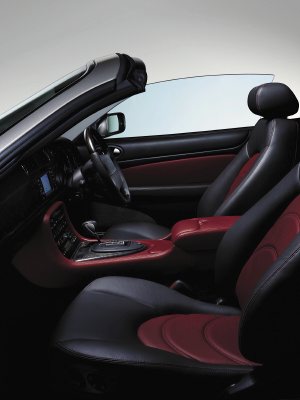
Pictures Jaguar Cars
In 2005, the XK8/XKR would receive a
final facelift with minor modifications to the body, particularly the
front end giving it a slightly more agressive look.
Visit
our complete "New" XK page for detailed information on the
Aluminum bodied 2007 XK !
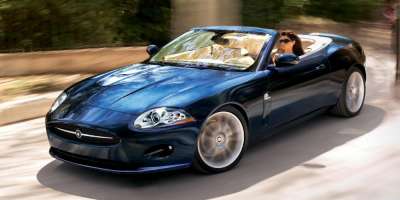
With early models now reaching very affordable
prices, XK8s and to some extent early XKRs can be very good buys. However,
as with any car but particularly luxury high performance models, maintenance
can be higher than anticipated. Maintenance records and a good inspection
by a Jaguar specialist are highly recommended.
The XK8 seem
to have very little significant problems as early models reach high
mileage although two issues can potentially be very costly.
Until 2000,
earlier version of Jaguar's AJ26 V8 engine used Nikasil cylinder liners
and a number of engines had to be replaced because of high wear of the
plating resulting in loss of compression and high blow by. High sulfur
content in gas and infrequent oil changes contributed to this problem
making it in some cases a regional isssue. Replacement engines use the
same steel liners Jaguar uses in 2000 and up engines but replacement
is obviously costly. A blowby test or compression check may be a good
precaution when buying an early car.
The VIN number
indicates what type of cylinder liners the engine has. Cars with VIN
ending with a 6 digits sequence have Nikasil liner engines whereas VIN
ending with the letter A followed by 5 digits have a steel liner engine.
More on this can be found in an article published in the May 2004 issue
of Classic Jaguar World Magazine which we were allowed to reproduce
here on Jag-Lovers (click
here for article)
The second
issue concerns the timing chain tensioners which have occasionaly failed
resulting in terminal engine damage... In nearly all cases, an engine
rattle after a cold start serve as a warning sign what the tensioners
are worn and need to be replaced. More on this can be found in an article
published in the dec 2003 issue of Classic Jaguar World Magazine which
we were allowed to reproduce here on Jag-Lovers (click
here for article)
|

